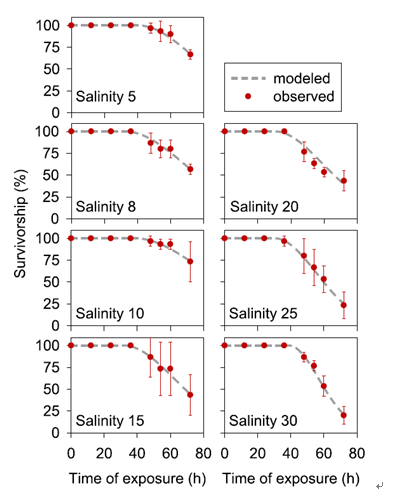作 者:Chen, WQ; Wang, WX;Tan, QG
影响因子:5.099
刊物名称: ENVIRONMENTAL POLLUTION
出版年份:2017
卷:222 页码: 323-330
The effects of salinity on metal toxicity are complex: not only affecting metal bioaccumulation, but also
altering the physiology and sensitivity of organisms. In this study, we used a toxicokinetic-toxicodynamic
(TK-TD) model to separate and quantify the dual effects of salinity on copper (Cu) toxicity in a euryhaline
clam Potamocorbula laevis. The toxicokinetics of Cu was determined using the stable isotope 65Cu as a
tracer at concentrations (10e500 mg L_1) realistic to contaminated environments and at salinities ranging
from 5 to 30. At low Cu concentrations (ca. 10 mg L_1), Cu bioaccumulation decreased monotonically with
salinity, and the uptake rate constant (ku, 0.546 L g_1 h_1 to 0.213 L g_1 h_1) fitted well with an empirical
equation, ku ? 1/(1.35 t 0.116$Salinity), by treating salinity as a pseudo-competitor. The median lethal
concentrations (LC50s) of Cu were 269, 224, and 192 mg L_1 at salinity 5, 15, and 30, respectively. At high
Cu concentrations (ca. 500 mg L_1), elevating salinity were much less effective in decreasing Cu bioaccumulation;
whereas Cu toxicity increased with salinity. The increased toxicity could be explained by
the increases in Cu killing rates (kks), which were estimated to be 0.44e2.08 mg mg_1 h_1 and were
presumably due to the osmotic stress caused by the deviation from the optimal salinity of the clams. The
other toxicodynamic parameter, internal threshold concentration (CIT), ranged from 79 to 133 mg_1 g_1
and showed no clear trend with salinity.

Fig. 17.The survivorship of the clam P. leavis during the 72-h exposure to 500 mg L1 Cu
(nominal) at salinities ranging from 5 to 30. The dots are the observed survivorship and
the error bars are standard deviation (n ¼ 3); and the dashed lines are the model fits.

